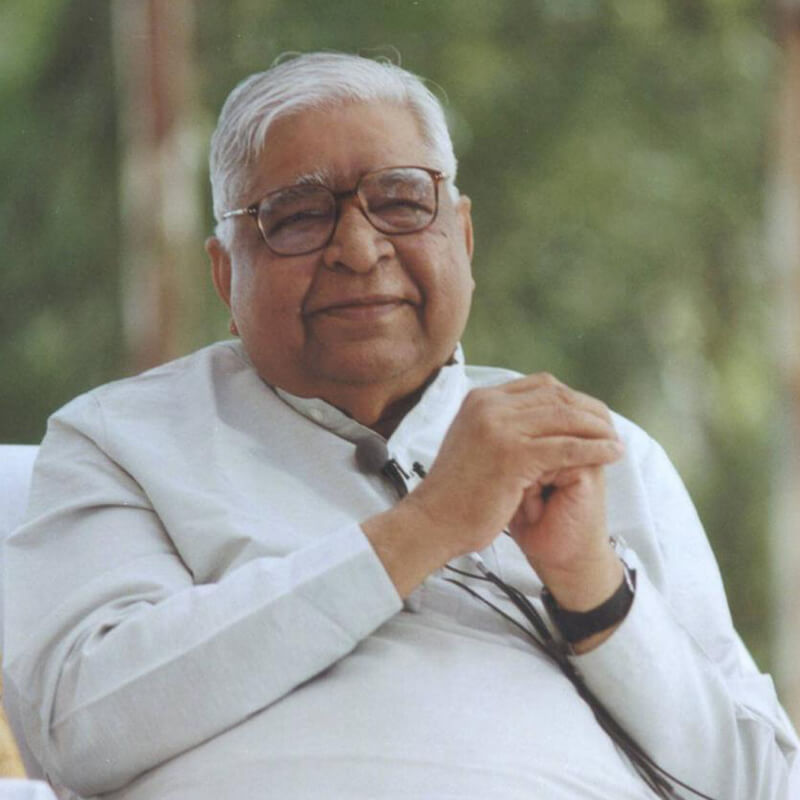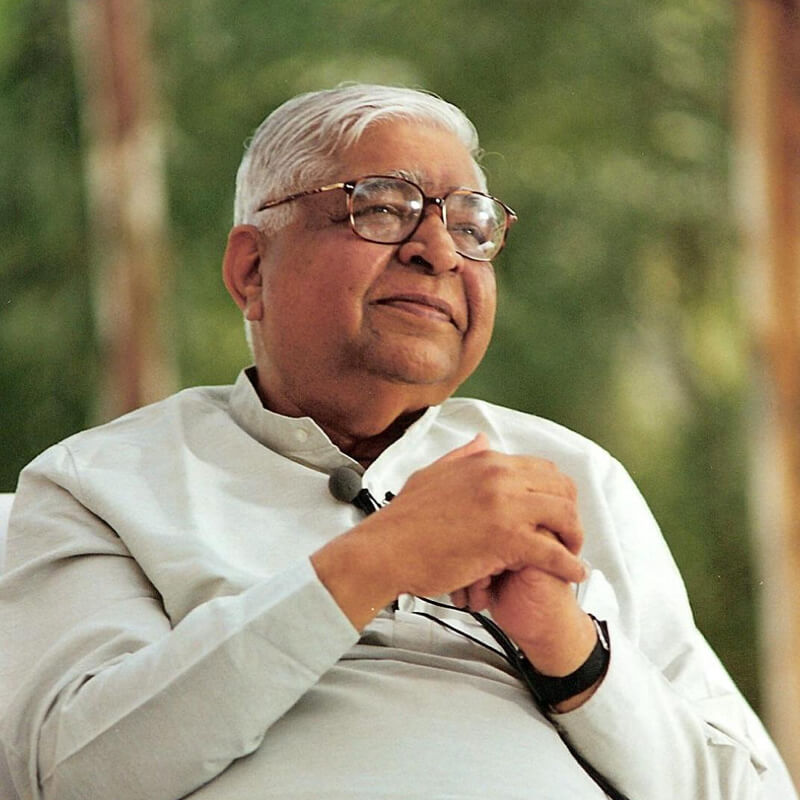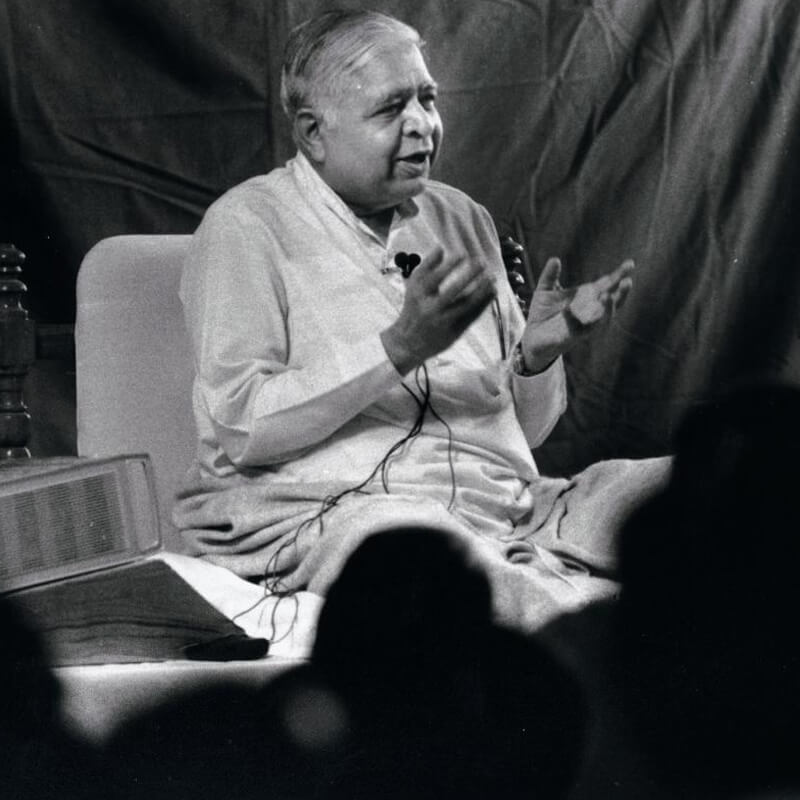(The following article is a condensed extract from Goenkaji’s foreword to the new edition of the Pāli Tipiṭaka being published by the Vipassana Research Institute. The Tipiṭaka is the literal recording of the words and teachings of the Buddha. It is divided into three Piṭakas (literally, baskets): Vinaya Piṭaka (the monastic discipline), Sutta Piṭaka (the popular discourses), and Abhidhamma Piṭaka (a compendium of profound teachings elucidating the functioning and inter-relationship of mind, mental factors, matter, and the phenomenon transcending all of these). The first volumes of this work appeared recently in Devanagari script, and versions in Roman script will follow—as will a book-length introduction by Goenkaji).
All of the Tipiṭaka is saturated with the noble and sacred personality of the Buddha. The material body (Rupakāya) of the Buddha was one appealing aspect of his personality; it possessed the 32 signs of a great man and radiated incomparable peace and beauty, pleasing for all to behold. But the other aspect of his personality was the unparalleled body of the Dhamma (Dhamma-kāya), which was suffused with complete enlightenment, perfect wisdom, moral behavior, right understanding, and compassion.
A Tathāgata or Buddha is a fully liberated being (arahata), having destroyed all the enemies, his impurities. He has attained perfect enlightenment (sammā- sambodhi). He is full of wisdom (vijjā) and is well established in the practice of morality and concentration (caraṇa). He is “well-gone” (sugato) because of his pleasant physical, vocal, and mental activities. He is the knower of the entire universe (lokavidu) understanding completely the mundane as well as the supramundane: nibbāna. He is peerless, without equal or superior (anuttaro). He directs untrained people to the right path, as a skilled charioteer manages untrained horses (purisa damma sārathi). He is the Teacher of gods and humans (satthā devamanussānam). He is Lord (bhagavā), having destroyed attachment, antipathy, and ignorance. Because of all these special qualities, he is different from others: he provides enormous welfare for the world.
The entire Tipiṭaka is permeated with the nectar of the Buddha’s Dhamma body. The Tipiṭaka contains the mellifluous sound of the Ganges of Dhamma arising from the Dhamma-kāya. It is suffused with the invaluable essence of emancipation. At every turn the Dhamma is illuminated, the Dhamma which is clearly expounded (svākkhāto), which takes us directly to the truth, helping us to leave behind all illusory imaginations (sandiṭhiko). It gives concrete, visible fruits here and now to those who follow the path (akāliko). It summons us to realize the truth (ehi passiko). With every step, it takes us to the highest goal of nibbāna (opanayiko), and is worth experiencing personally by every intelligent person (paccattam veditabbo viññuhiti).
Such is the noble Dhamma: universally beneficial to all; free from sectarianism; acceptable to all people, from all countries, in any age. The entire Tipiṭaka helps us savor this sweet nectar of Dhamma.
The Tipiṭaka also illumines the inspiring Sāvaka-saṅgha (the community of accomplished disciples), who drank deeply the ambrosial words of the Buddha. The Saṅgha clearly demonstrates that in Dhamma there is no place for blind faith, emotional devotion, or the logician’s hair-splitting intellectual acrobatics.
The Dhamma is immensely practical. One who follows it becomes a righteous practitioner (supaṭipanno), upright practitioner (ujupaṭipanno), wise practitioner (ñāyapaṭipanno), and proper practitioner (sāmicipaṭipanno) on the way to liberation. One becomes noble (ariyo) by attaining one of the four stages of liberation. Such a noble person is worthy of devotion, reverent salutation, honour, and offerings.
We are inspired to follow the path of Dhamma by beholding in the Tipiṭaka the Sāvaka-saṅgha, saintly persons who included both lay people and renunciants. Their pronouncements about their practical realizations hearten and thrill us, raising goose bumps and electrifying our practice of Vipassana.
Not only is the ancient spiritual and philosophical landscape of the India of 25 centuries ago brought to light in the Tipiṭaka, but a vivid spectrum of the historical, geographical, political, and cultural conditions of the times is also provided. The Tipiṭaka opens a window onto the administrative, educational, commercial, and industrial customs of the Buddha’s times. It sheds light on both social and individual conditions, in the urban as well as rural life of ancient India. The India of 2,500 years ago comes alive in the Tipiṭaka.
Although the wisdom expounded by the Buddha apparently disappeared from India, in reality it has flowed through subsequent Indian literature. Sanskrit, as well as Hindi and other regional literature, is full of the benevolent teachings. Words of the medieval saints of India are suffused with the wisdom of the Buddha.
The influence of the Buddha’s contribution is not confined to Indian thought; the deep impact of his teaching is also visible in the spiritual thought and literature of the rest of the world. Therefore the Buddha’s words have a special significance for the human race even today. The stately grandeur of the Buddha’s teaching is verdant forever. It is the perennial forerunner of the resurrection of fallen human values. What could be more relevant in this age of moral degradation, with its inevitable result of downtrodden people afflicted with terror?
A study of the Tipiṭaka will correct some of the prevalent misconceptions about the Buddha. One is that, since the Buddha was a recluse, his followers were also recluses, and his teachings were therefore meant for recluses only, not for lay people. Examination of the Dhamma literature will totally dispel such myths. The reality is that the Buddha was very popular among the masses in his lifetime; his lay devotees outnumbered monks and nuns. He was nearly as popular among the recluses and ascetics of his day as he was with the lay people of northern India.
During the rainy season the Buddha would stay for three months in one place. He often spent this time near densely populated towns such as Sāvatthi or Rājagaha, so that more people might take advantage of his presence and teachings. After these retreats, he would undertake Dhamma wanderings in the villages, towns, and cities situated in the land of the Ganges and Yamuna rivers in northern India. He disseminated the Dhamma and gave guidance in the technique of Vipassana to hundreds of thousands of people.
Wherever he went, crowds of people gathered to see him and listen to his discourses. At the same time, many people would come to meet him alone. Impressed by his benevolent speech, lay people would invite the Buddha and his monks to accept their offerings of meals at their homes. Again they benefited from his teachings. The recluses of the day used to come to him for religious discussions and sometimes for debates, but the majority of his visitors were lay people. A detailed account of his relationship to the people is conspicuous in this literature.
The Buddha delivered thousands of Dhamma discourses, from the time he attained enlightenment until he passed away 45 years later. Inspired by the pure Dhamma, not only recluses and ascetics but lay people from every tradition, every belief, every profession, every class came to him and profited by walking on the path of Dhamma.
Whether kings, queens, princes, generals maidservants, royal servants and their children, physicians, philanthropists, ascetics, beggars, wanderers, wealthy housewives, courtesans, sweepers, high or low caste—whoever came into contact with the Buddha and took a dip in the Ganges of Dhamma by practicing Vipassana was totally changed, totally rectified. Their suffering was eradicated.
Another prevalent misconception about the Buddha is that he taught how to gain release from the cycle of repeated existences, but he ignored the everyday concerns of the individual and the family. It is held that he was indifferent to political and social problems. Study of the Tipiṭaka reveals that he was cognizant of and sensitive to worldly problems. While it is true that he gave the majority of his discourses to monks, explaining the topic of the ultimate truth, nevertheless he delivered numerous discourses to his lay followers addressing mundane concerns. He dealt with all aspects of lay life.
He gave instructions concerning the mutual duties of parent and child, wife and husband, master and servant, teacher and student, friend and friend, king and subject. These are refreshing, relevant, and beneficial even today. The advice given to the Licchavas, for the maintenance of adequate protection of their republic, are a model for any republican government of modern times. Similarly, his teachings are equally valuable for other administrators. In the tradition of his teachings it is said: “The king should protect his subjects in the same way as he protects his own children (Rājā rakkhatu dhammena attano va pajam pajam).”
Inspired by such words, the emperor Dhammarāja Asoka established a righteous administration which was unique and unparalleled in human history and worthy of emulation. His reign shines like a luminous pillar of light in the administrative history of India, indeed of the entire world.
Yet another major misconception about the Buddha is that he lay undue emphasis on suffering in his discourses. Some people have commented that his teaching is primarily about suffering and is therefore negative and pessimistic, full of despair and inclining towards apathy. With the publication of this literature, these misconceptions will be corrected. It will become evident that there is no comparable literature which inspires confidence in, and provides solace to, people who are sunk in abject suffering and despair.
Truly a patient is discouraged when told that his or her disease is incurable. But if someone makes the patient aware of the disease, discovers its primary cause and offers a way of removing the cause by pointing out a medicine which can totally eradicate the disease, this is a blessing for the patient. What could possibly be a source of greater hope and solace for the patient than this?
It is exactly the same with the Buddha’s explanation of suffering. However bitter it may be, suffering is a universal truth in the lives of beings. It cannot be denied. The Buddha not only revealed the fundamental truth of suffering, he made its cause crystal clear and he thoroughly delineated the simple, easily acceptable art of living of Vipassana, consisting of the Eightfold Noble Path.
This art of living is not merely a philosopher’s theoretical or intellectual exposition; it is an entirely pragmatic, proven path, which gives visible results here and now to those who practice it. It gives hope to those who are discouraged and mired in suffering. It grants peace and happiness in both the mundane and supramundane fields of life.
The teachings of the Buddha completely uproot the discrimination of caste and the pollution of communalism. Relief from these poisons is a pressing need in India as well as the rest of the world today. Their removal will help bring much-longed-for peace and happiness.
The Buddha’s discourse to the Kālāmas of Kesamutta is the first declaration of human rights and is a beacon for all humanity, enunciating the principle of freedom of thought. All his teaching is free from blind faith and corrupt clericalism. It is completely empirical, impartial, and dedicated to intellectual rigor. Therefore it is universally acceptable.
Practitioners of Vipassana who read these texts may feel as if the Exalted One has understood their difficulties and has given instructions which are for them alone—as if the Buddha is personally exhorting them with deep understanding and love. The publication of such ambrosial words will prove a great boon to them.
May the publication of the words of the Buddha and the other Pāli texts be helpful and beneficial to all. May the dawn of peace, happiness and liberation arise for all the readers.
(Courtesy: International Vipassana Newsletter 1994 issue)





